The Effects of Xanthan Gum and Guar Gum on the Mechanical Properties of Sand–Bentonite Mixtures
Abstract
1. Introduction
2. Materials and Methods
2.1. Materials
2.1.1. Sand
2.1.2. Na–Bentonite Clay
2.1.3. Biopolymers
2.1.4. Xanthan Gum (XG)
2.1.5. Guar Gum (GG)
2.2. Sample Preparation and Testing Protocol
2.2.1. Material Proportioning
2.2.2. Material Drying
2.2.3. Dry Mixing of Biopolymers
2.2.4. Incorporation of Distilled Water
2.2.5. Curing Procedure
2.2.6. Compaction and Molding
2.2.7. Control Samples
2.2.8. Examination Protocol
2.3. Fourier Transform Infrared Spectroscopy (FTIR) Analysis
3. Results
3.1. Optimum Moisture Content (OMC) and Maximum Dry Density (MDD)
3.2. Examination of MDD and OMC Outcomes
3.2.1. Impact of Xanthan Gum on MDD and OMC
3.2.2. The Impact of Guar Gum on MDD and OMC
3.2.3. Comparison Between Xanthan Gum and Guar Gum
3.3. Unconfined Compressive Strength (UCS)
3.3.1. Unconfined Compressive Strength (UCS) of Sand–Bentonite Mixtures Treated with Guar Gum and Xanthan Gum
3.3.2. Impact of Guar Gum Concentration and Curing Time on Unconfined Compressive Strength
3.3.3. Relationship Between UCS and Strain for Guar Gum and Xanthan Gum
3.4. Failure Patterns in UCS Tests
3.5. Fourier Transform Infrared Spectroscopy (FTIR) Analysis Results
3.6. FTIR Spectral Characteristics
- Si-O-Si stretching vibrations: A strong absorption band was observed around 1000–1100 cm−1, corresponding to the silicate framework of sand and bentonite. This peak remained prominent across all samples, indicating the structural integrity of the mineral phase [29].
- O-H stretching vibrations: The broad absorption band around 3200–3600 cm−1 corresponds to hydroxyl (-OH) groups found in both the bentonite and the biopolymer matrix. In the original FTIR spectra obtained from oven-dried samples, this peak appeared relatively weak, which raised concerns regarding the possible thermal degradation or suppression of hydrogen bonding. To address this, a second FTIR analysis was conducted on selected samples (SB + 0.5%, 1%, and 2% XG) that were air-dried at room temperature. As shown in Figure 16, the resulting spectra revealed clearer and more intense O-H absorption bands, indicating that these functional groups are better preserved under milder drying conditions. The increasing peak intensity with higher biopolymer content further supports the role of xanthan gum in enhancing hydrophilicity and promoting hydrogen bonding within the soil matrix [29].
- C-H stretching vibrations: Peaks observed around 2800–2950 cm−1 correspond to the aliphatic C-H stretching vibrations from the biopolymers, particularly xanthan gum and guar gum [29].
- C=O stretching vibrations: The absorption band near 1600–1650 cm−1 was attributed to the carboxyl (-COO−) functional groups from the biopolymers. The peak intensity increased with higher biopolymer content, signifying enhanced organic interactions [29].
- Si-O bending vibrations: The peak around 470–500 cm−1, characteristic of Si-O bending, was detected in all samples, confirming the presence of silicate minerals [30].
3.7. Effect of Biopolymer Addition on FTIR Spectra
- Increase in O-H Absorption: A noticeable enhancement in the 3200–3600 cm−1 band suggests increased hydrogen bonding due to the presence of hydrophilic biopolymers (Figure 15). This implies greater water retention, which may influence swelling and consolidation behavior.
- Shift in C=O Absorption: A slight shift in the 1600–1650 cm−1 region suggests interactions between the biopolymers and bentonite, potentially forming new hydrogen bonds or ionic interactions.
- Intensity Variations in Si-O-Si Peaks: Although the Si-O-Si peak remained present, slight intensity changes were observed with increasing biopolymer content, which may be linked to surface modifications or interactions between the biopolymers and the mineral phase.
3.8. Interpretation of the Mechanical Behavior of Xanthan Gum-Treated Sand–Bentonite Based on UCS and E50
4. Discussion
5. Conclusions
Author Contributions
Funding
Institutional Review Board Statement
Informed Consent Statement
Data Availability Statement
Conflicts of Interest
References
- Chang, I.; Im, J.; Cho, G.C. Geotechnical engineering behaviors of gellan gum biopolymer treated sand. Can. Geotech. J. 2016, 53, 1658–1670. [Google Scholar] [CrossRef]
- Gao, T.; Shen, L.; Shen, M.; Chen, F.; Liu, L.; Gao, L. Analysis on differences of carbon dioxide emission from cement production and their major determinants. J. Clean. Prod. 2015, 103, 160–170. [Google Scholar] [CrossRef]
- Andrew, R.M. Global CO2 emissions from cement production, 1928–2018. Earth Syst. Sci. Data 2019, 11, 1675–1710. [Google Scholar] [CrossRef]
- Ayeldeen, M.; Negm, A.; El-Sawwaf, M.; Kitazume, M. Enhancing mechanical behaviors of collapsible soil using two biopolymers. J. Rock Mech. Geotech. Eng. 2017, 9, 329–339. [Google Scholar] [CrossRef]
- Cabalar, A.F.; Awraheem, M.H.; Khalaf, M.M. Geotechnical properties of a low-plasticity clay with biopolymer. J. Mater. Civ. Eng. 2018, 30, 04018170. [Google Scholar] [CrossRef]
- Chen, C.; Wu, L.; Perdjon, M.; Huang, X.; Peng, Y. The drying effect on xanthan gum biopolymer treated sandy soil shear strength. Constr. Build. Mater. 2019, 197, 271–279. [Google Scholar] [CrossRef]
- Kumar, S.; Yadav, B.D.; Raj, R. A review on the application of biopolymers (xanthan, agar and guar) for sustainable improvement of soil. SN Appl. Sci. 2024, 6, 393. [Google Scholar] [CrossRef]
- Soldo, A.; Miletić, M.; Auad, M.L. Biopolymers as a sustainable solution for the enhancement of soil mechanical properties. Sci. Rep. 2020, 10, 267. [Google Scholar] [CrossRef]
- Chang, I.; Im, J.; Prasidhi, A.K.; Cho, G.C. Effects of xanthan gum biopolymer on soil strengthening. Constr. Build. Mater. 2015, 74, 65–72. [Google Scholar] [CrossRef]
- Mudgil, D.; Barak, S.; Khatkar, B.S. X-ray diffraction, IR spectroscopy and thermal characterization of partially hydrolyzed guar gum. Int. J. Biol. Macromol. 2012, 50, 1035–1039. [Google Scholar] [CrossRef]
- Bagheri, P.; Gratchev, I.; Rybachuk, M. Effects of xanthan gum biopolymer on soil mechanical properties. Appl. Sci. 2023, 13, 887. [Google Scholar] [CrossRef]
- Rashid, A.S.A.; Latifi, N.; Meehan, C.L.; Manahiloh, K.N. Sustainable improvement of tropical residual soil using an environmentally friendly additive. Geotech. Geol. Eng. 2017, 35, 2613–2623. [Google Scholar] [CrossRef]
- Ghadr, S.; Assadi-Langroudi, A. Structure-based hydro-mechanical properties of sand-bentonite composites. Eng. Geol. 2018, 235, 53–63. [Google Scholar] [CrossRef]
- Iravanian, A. Hydro-Mechanical Properties of Compacted Sand-Bentonite Mixtures Enhanced with Cement. Ph.D. Thesis, Eastern Mediterranean University, Gazimağusa, North Cyprus, 2015. [Google Scholar]
- Garoushi, A.H.B.; Uygar, E. Biopolymer and gypsum added Na bentonite for a more effective clay liner. Arab. J. Sci. Eng. 2024. [Google Scholar] [CrossRef]
- Alibrahim, B.; Garoushi, A.H.B.; Uygar, E. The role of calcium-based additives in bentonite stabilization: A comparative evaluation. Arab. J. Sci. Eng. 2024. [Google Scholar] [CrossRef]
- Rong, X.; Deng, S.; Liang, B.; Zhuang, J.; Yu, Y.; Wu, Z. Mechanical behavior and strengthening mechanism of loess stabilized with xanthan gum and guar gum biopolymers. Mater. Res. Express 2024, 11, 105305. [Google Scholar] [CrossRef]
- Dehghan, H.; Tabarsa, A.; Latifi, N.; Bagheri, Y. Use of xanthan and guar gums in soil strengthening. Clean Technol. Environ. Policy 2019, 21, 155–165. [Google Scholar] [CrossRef]
- Hassler, R.A.; Doherty, D.H. Genetic engineering of polysaccharide structure: Production of variants of xanthan gum in Xanthomonas campestris. Biotechnol. Prog. 1990, 6, 182–187. [Google Scholar] [CrossRef]
- Nsengiyumva, E.M.; Alexandridis, P. Xanthan gum in aqueous solutions: Fundamentals and applications. Int. J. Biol. Macromol. 2022, 216, 583–604. [Google Scholar] [CrossRef]
- Wan, J.; Liu, C.; Xiao, H.; Lin, W.; Tang, Z.; Jia, Y. Study on planting and mechanical properties of clay modified by xanthan gum and guar gum. Preprints 2024. [Google Scholar] [CrossRef]
- Seema, M.; Phool, C.; Neelkant, P.; Hina, C.; Tajdar, S.A.; Mahor, S. A review on natural plant-based polymers: A brilliant pharmaceutical excipient. Int. J. Pharm. Sci. Rev. Res. 2022, 75, 24–30. [Google Scholar]
- Prajapati, V.D.; Jani, G.K.; Moradiya, N.G.; Randeria, N.P. Pharmaceutical applications of various natural gums, mucilages and their modified forms. Carbohydr. Polym. 2013, 92, 1685–1699. [Google Scholar] [CrossRef] [PubMed]
- Mudgil, D.; Barak, S.; Khatkar, B.S. Guar gum: Processing, properties and food applications—A review. J. Food Sci. Technol. 2014, 51, 409–418. [Google Scholar] [CrossRef] [PubMed]
- ASTM D2166/D2166M-16; Standard Test Method for Unconfined Compressive Strength of Cohesive Soil. ASTM International: West Conshohocken, PA, USA, 2010. [CrossRef]
- Madejová, J. FTIR techniques in clay mineral studies. Vib. Spectrosc. 2003, 31, 1–10. [Google Scholar] [CrossRef]
- ASTM D6348-12; Standard Test Method for Determination of Gaseous Compounds by Extractive Direct Interface Fourier Transform Infrared (FTIR) Spectroscopy. ASTM International: West Conshohocken, PA, USA, 2020. [CrossRef]
- García-Ochoa, F.; Santos, V.E.; Casas, J.A.; Gómez, E. Xanthan gum: Production, recovery, and properties. Biotechnol. Adv. 2000, 18, 549–579. [Google Scholar] [CrossRef]
- Stuart, B. Infrared Spectroscopy: Fundamentals and Applications; John Wiley & Sons: Chichester, UK, 2004. [Google Scholar]
- Lemboye, K.; Almajed, A. Effect of varying curing conditions on the strength of biopolymer modified sand. Polymers 2023, 15, 1678. [Google Scholar] [CrossRef]
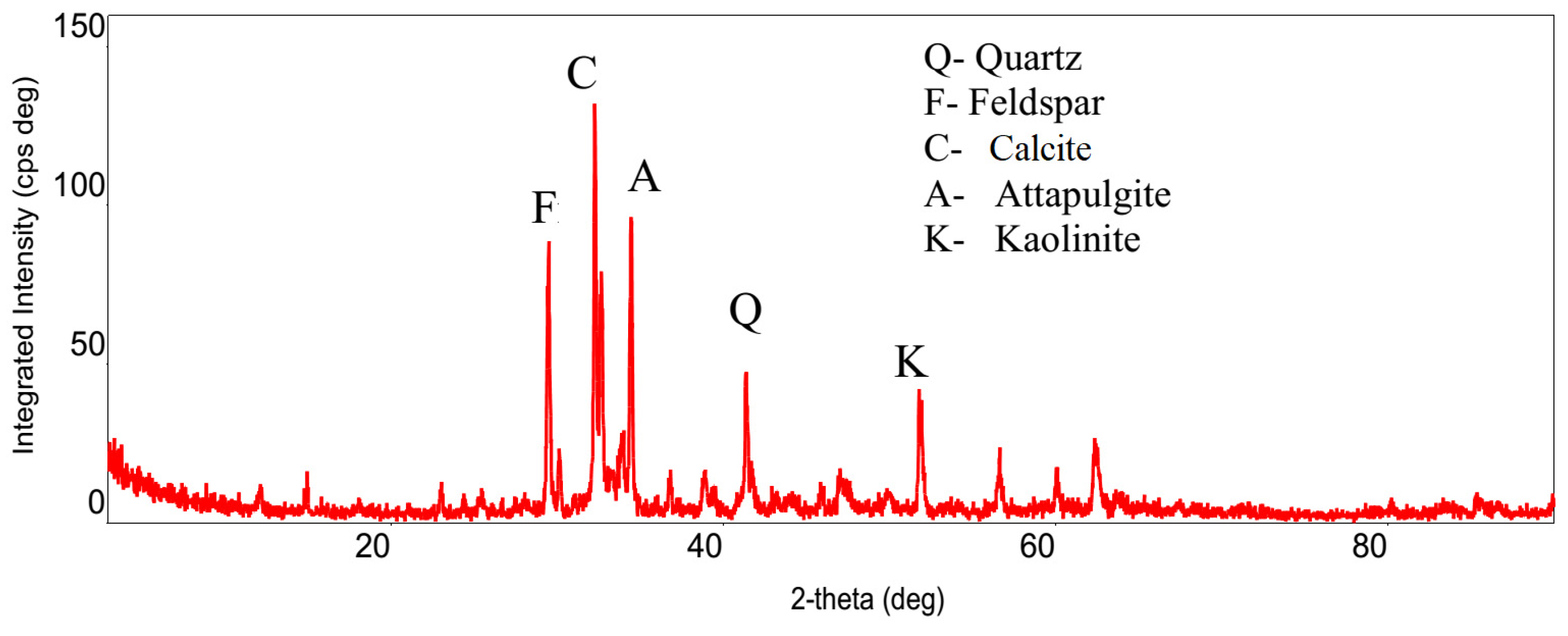
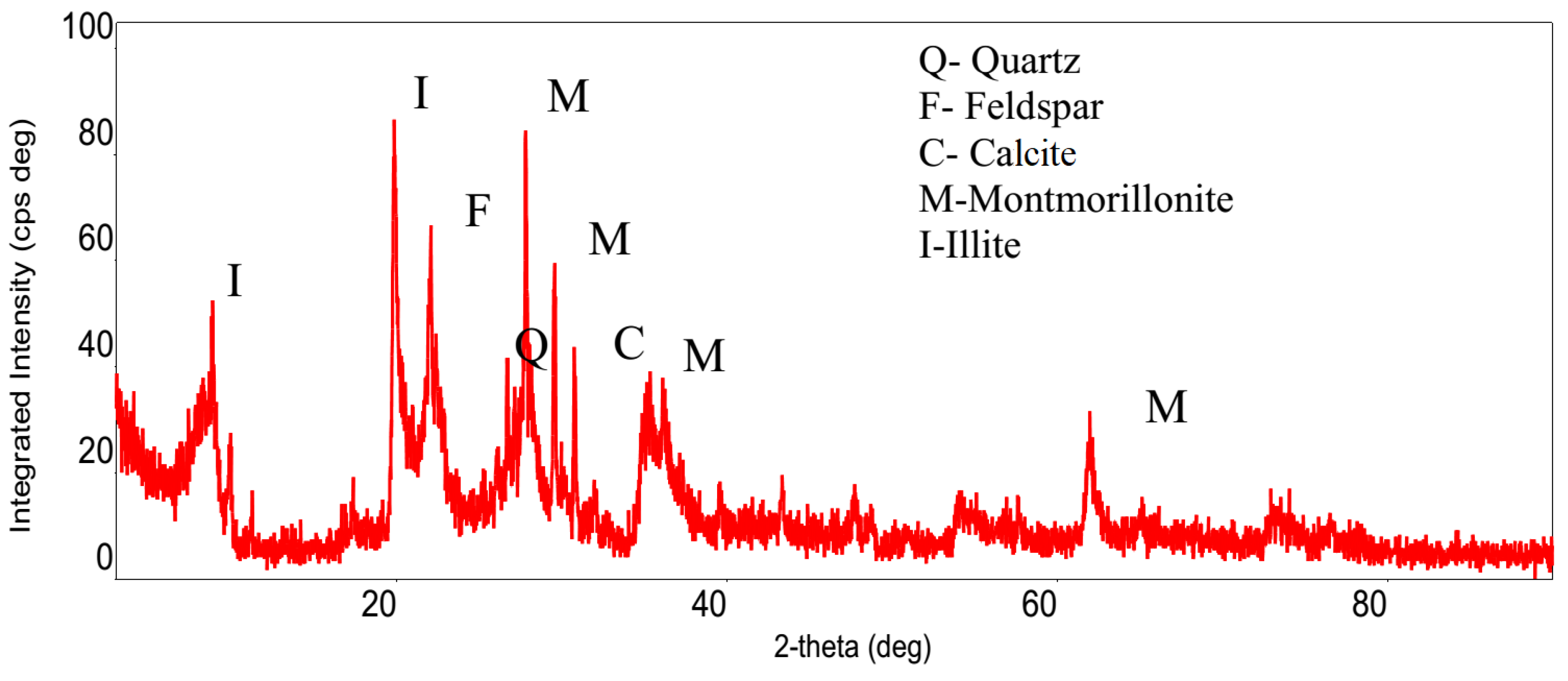

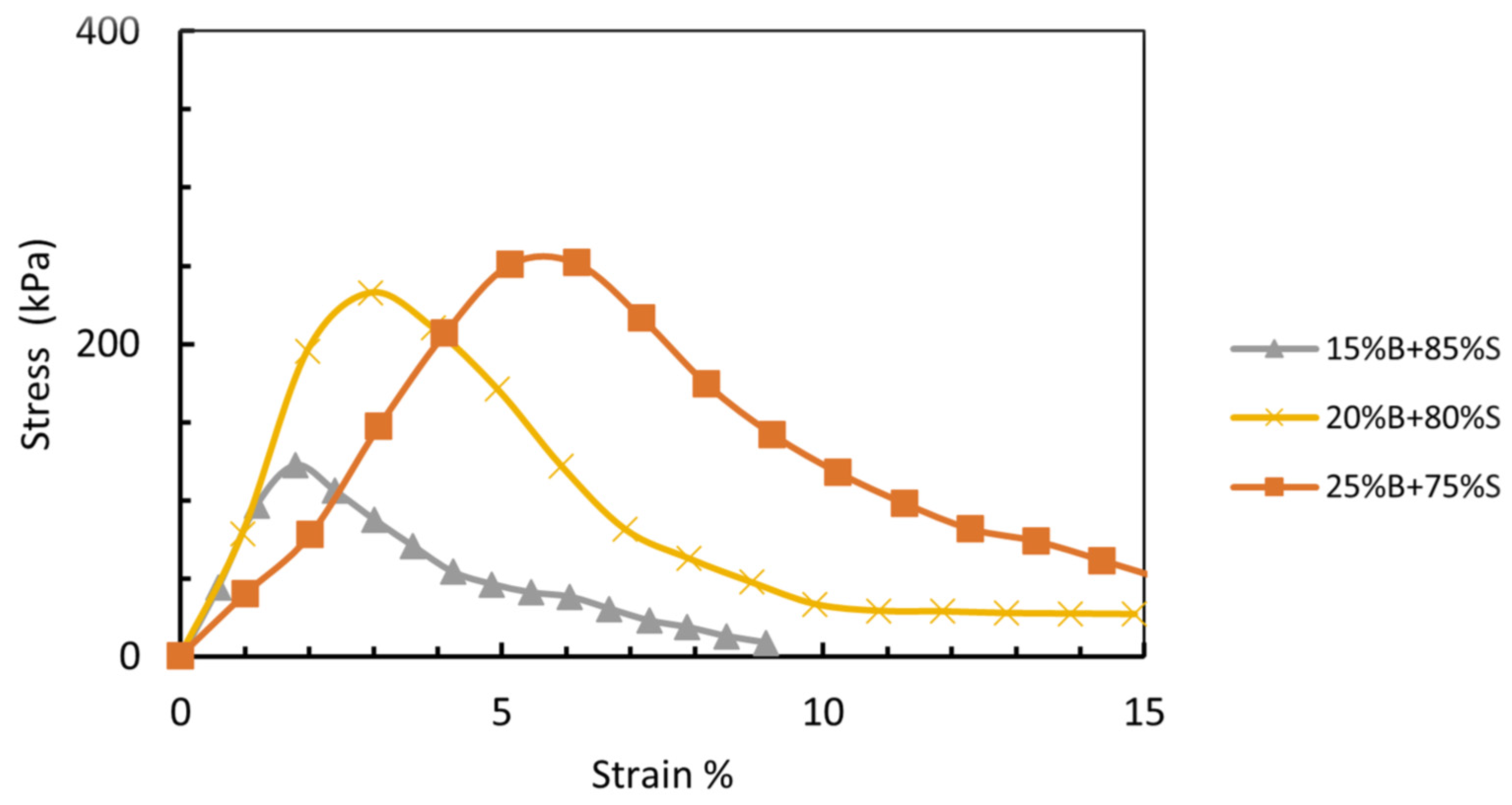



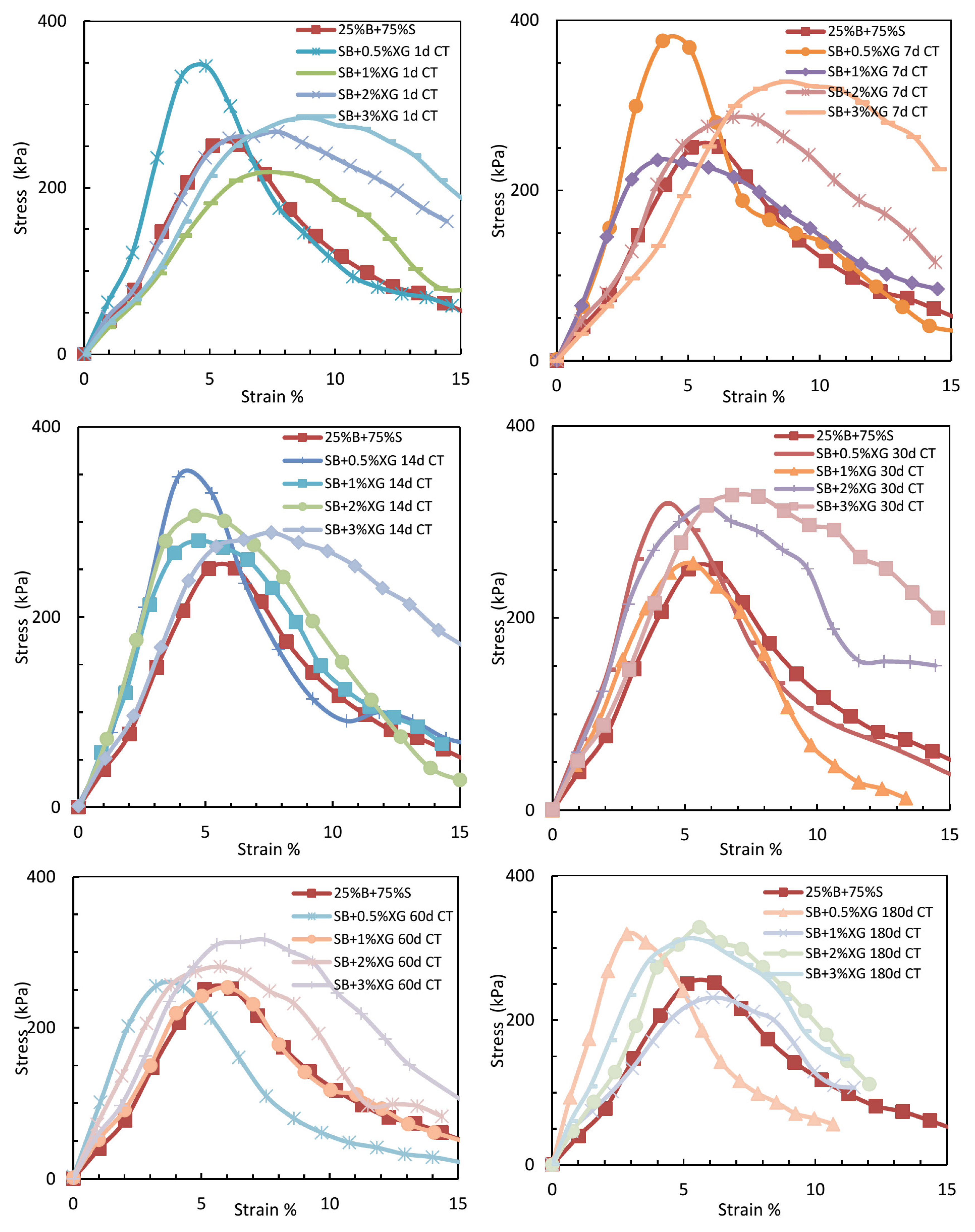
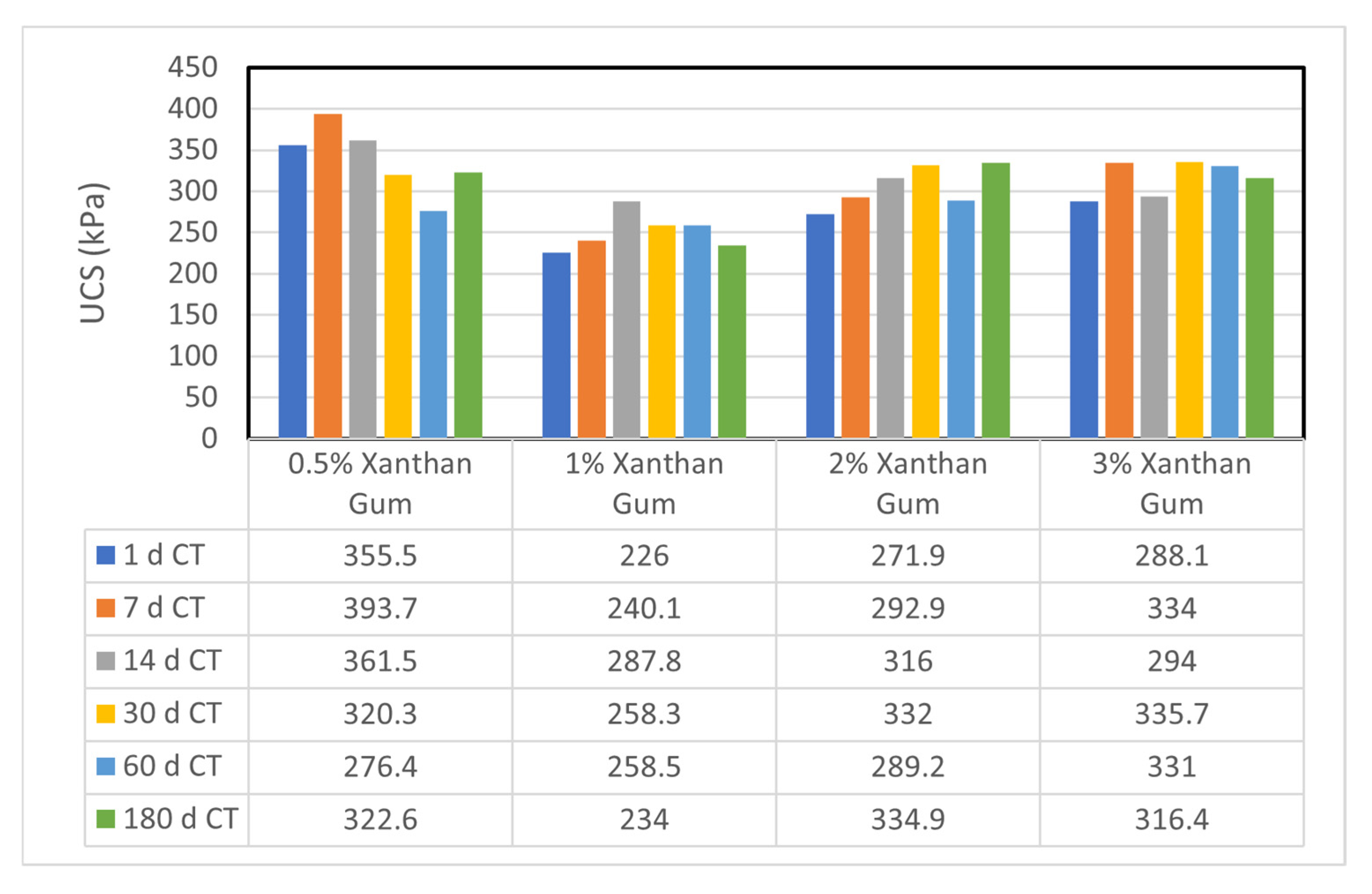
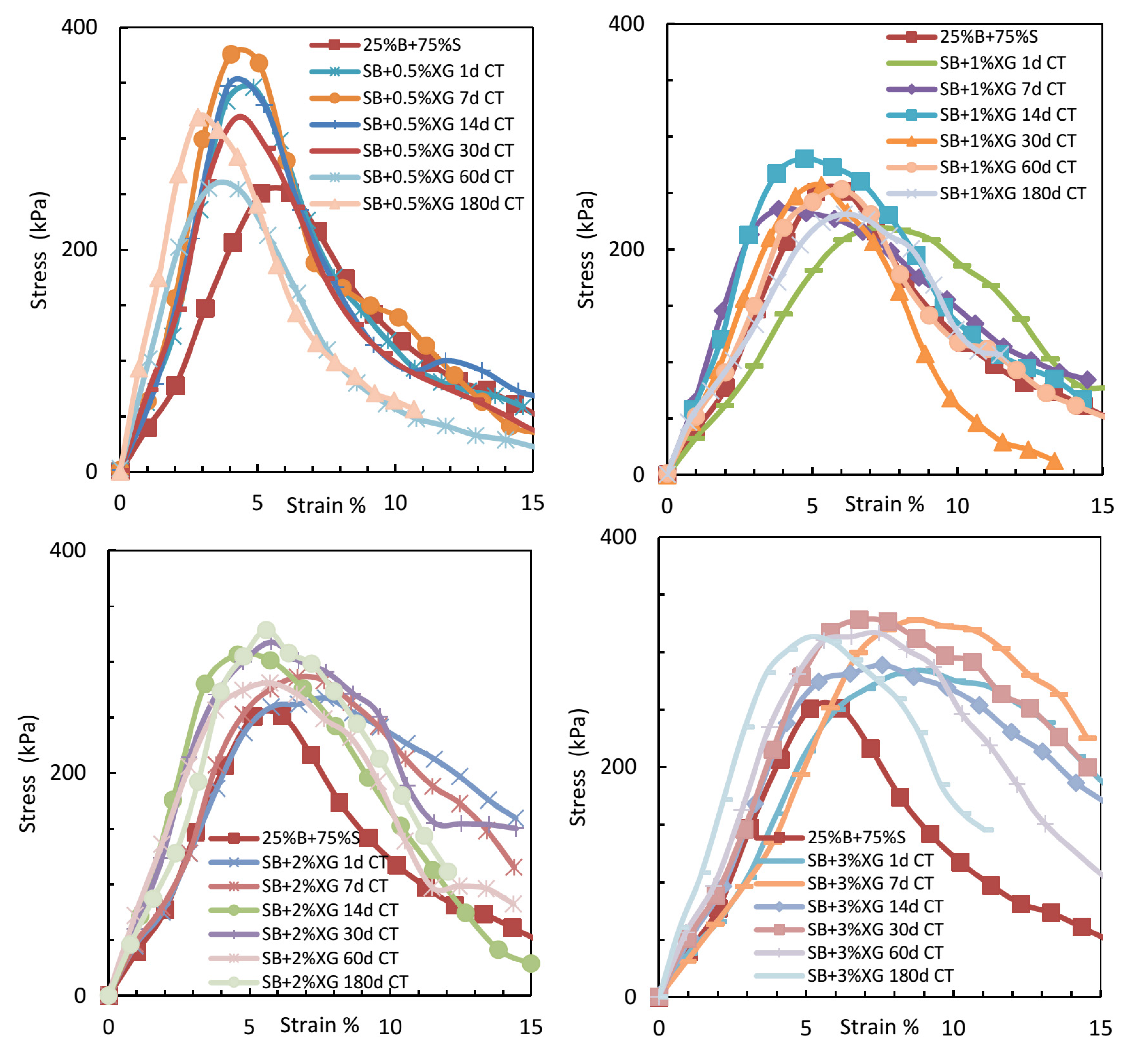
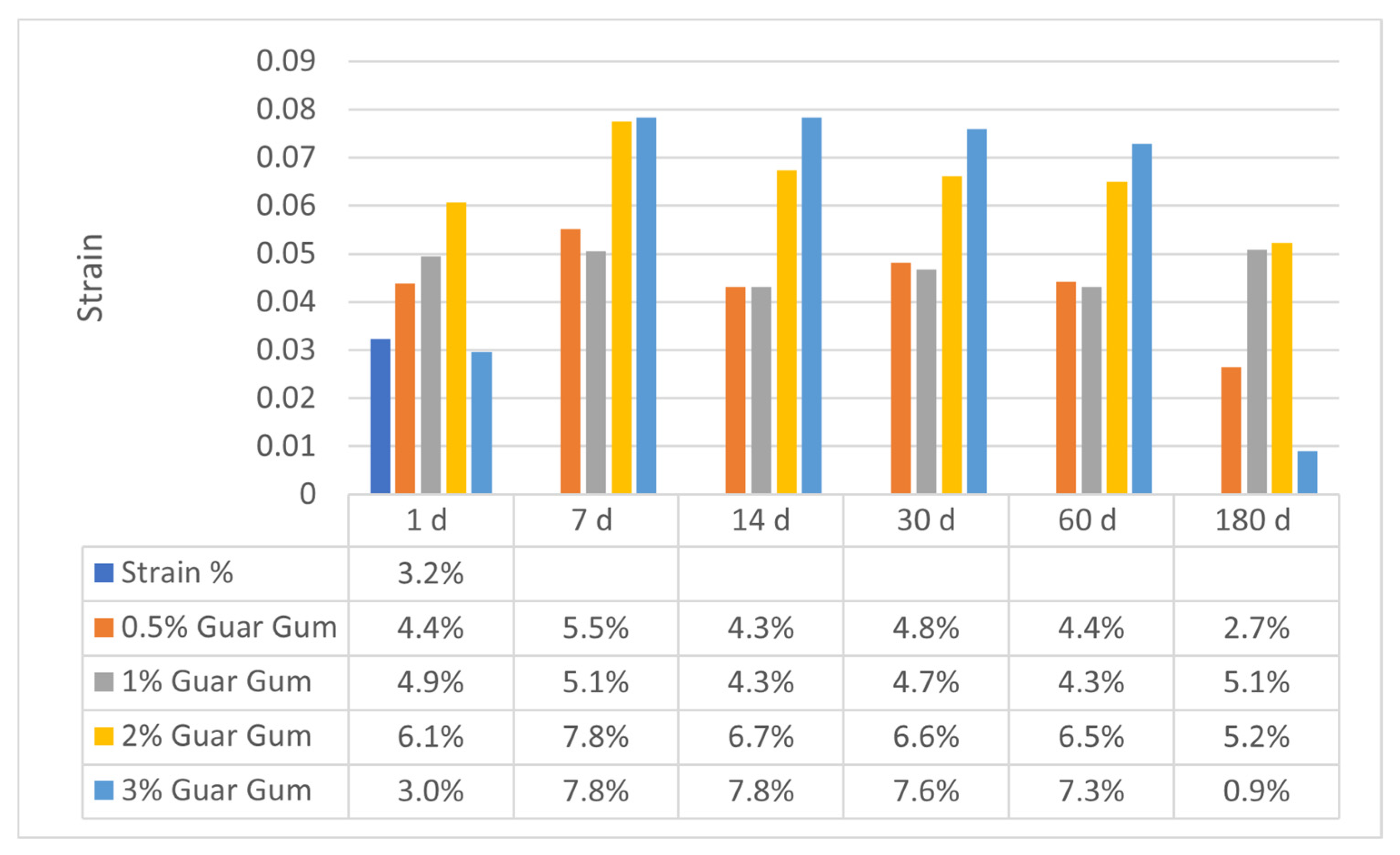
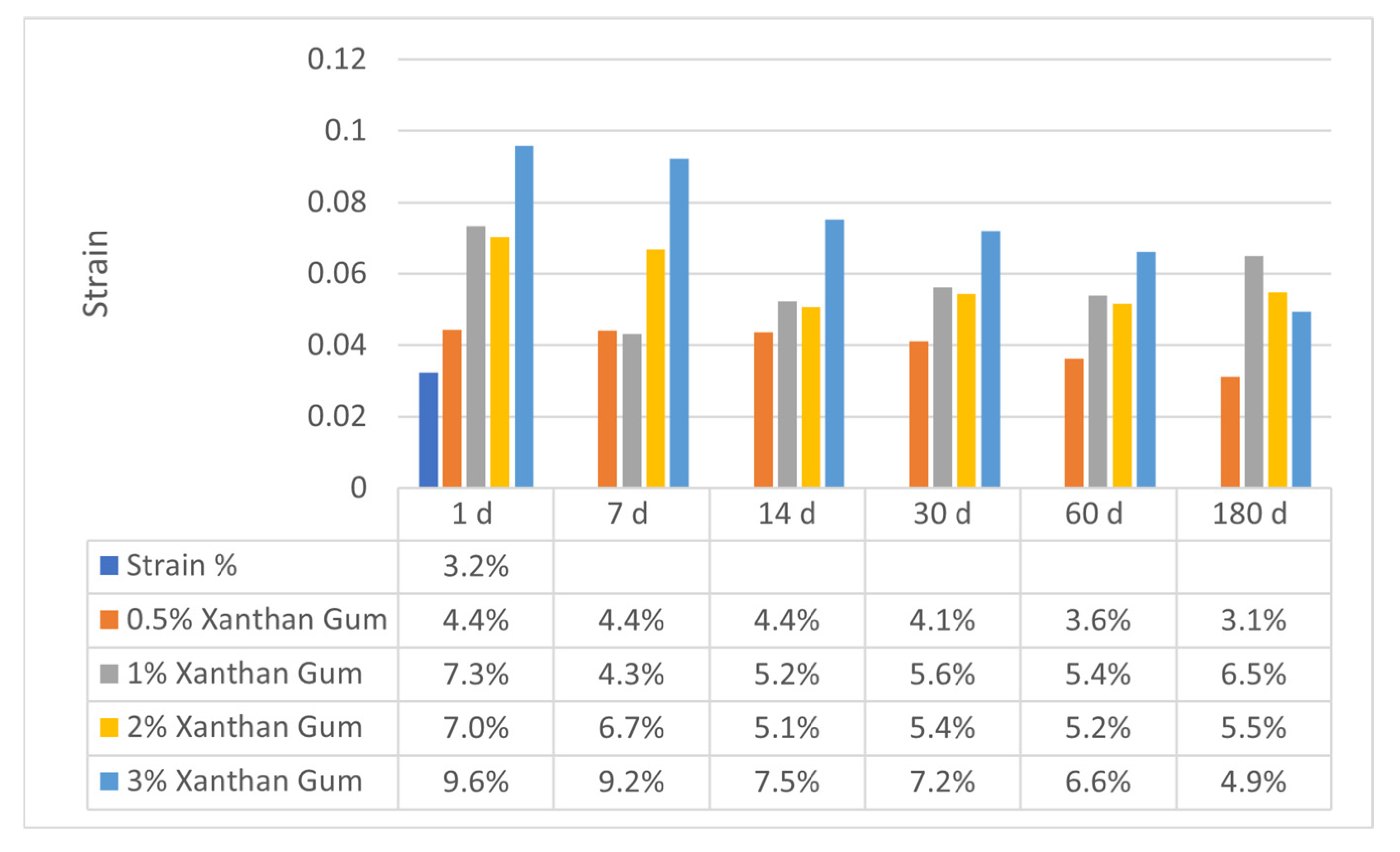
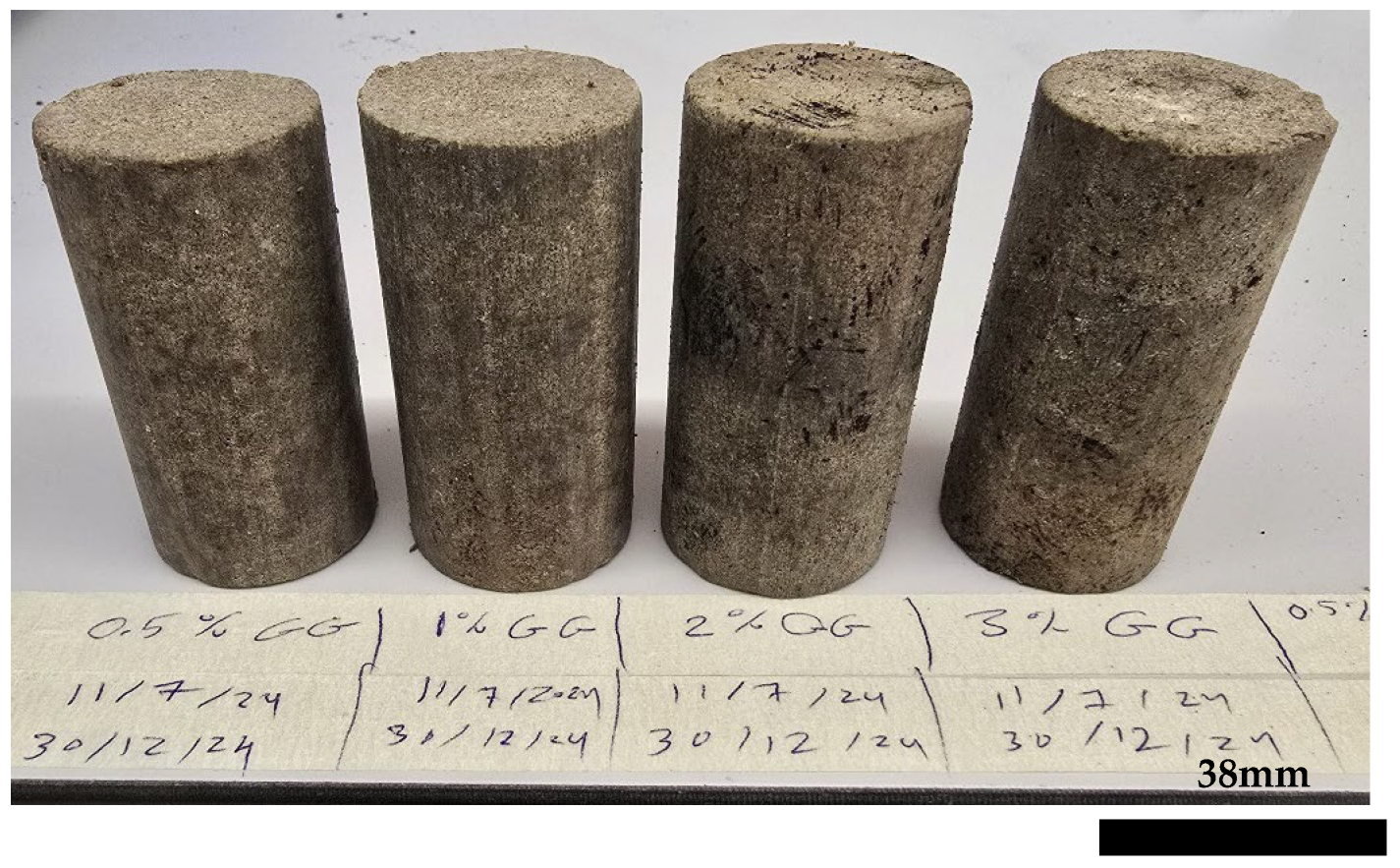

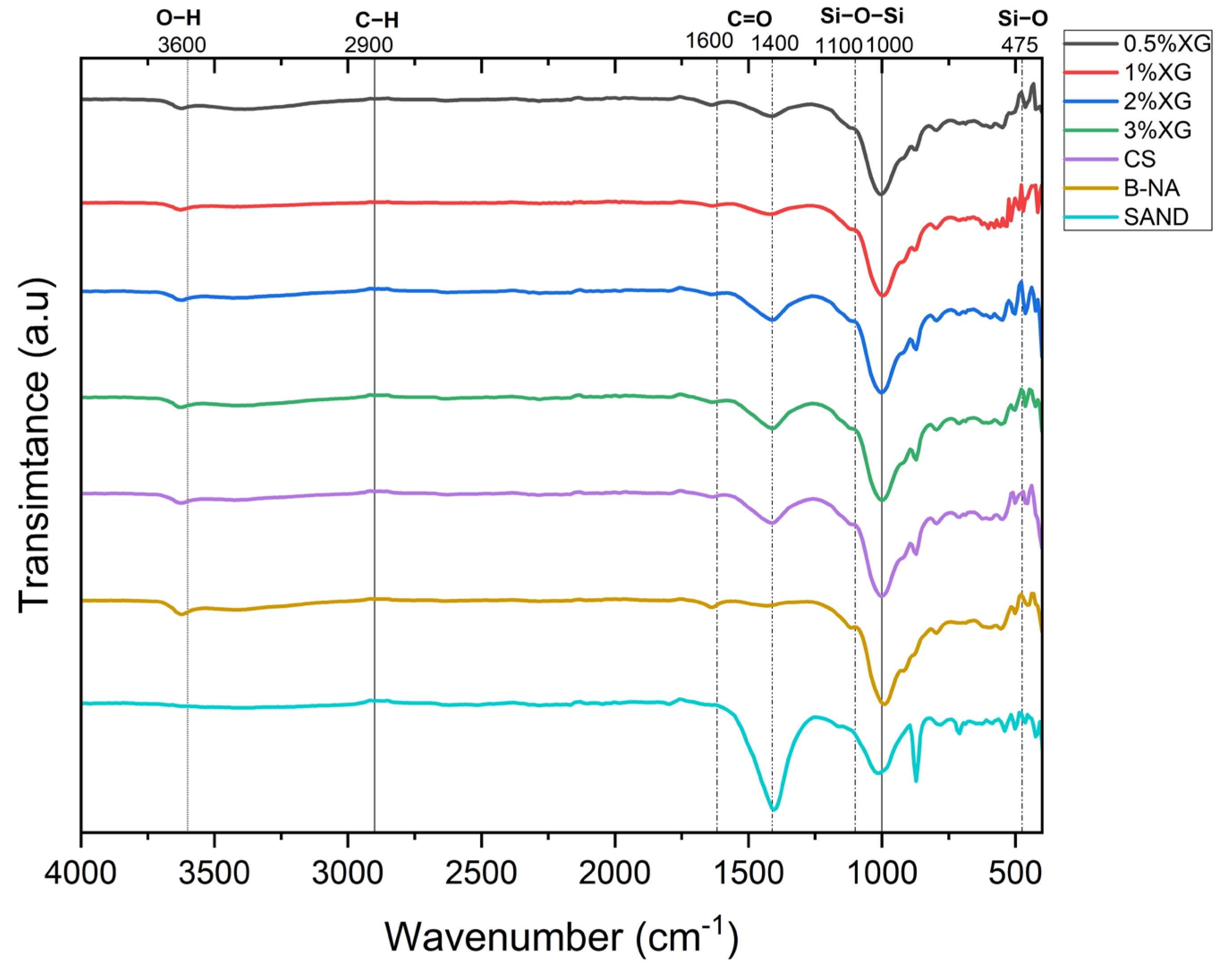

| Parameters | |
|---|---|
| Uniformity coefficient Cu | 1.53 |
| Coefficient of curvature Cc | 0.99 |
| Effective diameter D10 (mm) | 0.14 |
| Mean diameter D50 (mm) | 0.20 |
| Biopolymer Concentration | MDD (g/cm3) | OMC (%) |
|---|---|---|
| Xanthan Gum (%) | ||
| 0 | 1.81 | 17.5 |
| 0.5 | 1.81 | 17 |
| 1 | 1.80 | 15.5 |
| 2 | 1.78 | 16.5 |
| 3 | 1.73 | 19.5 |
| Guar gum (%) | ||
| 0 | 1.81 | 17.5 |
| 0.5 | 1.80 | 17.5 |
| 1 | 1.78 | 17 |
| 2 | 1.78 | 16.5 |
| 3 | 1.78 | 15 |
| 0.5%XG | 1%XG | 2%XG | 3%XG | |||||
|---|---|---|---|---|---|---|---|---|
| CT (Day) | E50 kPa | UCS kPa | E 50 kPa | UCS kPa | E 50 kPa | UCS kPa | E 50 kPa | UCS kPa |
| 1 | 10,000 | 355.5 | 3571.4 | 226 | 4477.6 | 271.9 | 3846.2 | 288.1 |
| 7 | 13,500 | 393.7 | 7500 | 240.1 | 4807.7 | 292.9 | 3658.5 | 334 |
| 14 | 10,000 | 361.5 | 7142.9 | 287.8 | 7500 | 316 | 5000 | 294 |
| 28 | 6976.7 | 320.3 | 5769.2 | 258.3 | 6976.7 | 332 | 5000 | 335.7 |
| 60 | 9375 | 276.4 | 4918. | 258.5 | 7500 | 289.2 | 5555.6 | 331 |
| 180 | 12,500 | 322.6 | 4411.8 | 234 | 5555.6 | 334.9 | 7500 | 316.4 |
Disclaimer/Publisher’s Note: The statements, opinions and data contained in all publications are solely those of the individual author(s) and contributor(s) and not of MDPI and/or the editor(s). MDPI and/or the editor(s) disclaim responsibility for any injury to people or property resulting from any ideas, methods, instructions or products referred to in the content. |
© 2025 by the authors. Licensee MDPI, Basel, Switzerland. This article is an open access article distributed under the terms and conditions of the Creative Commons Attribution (CC BY) license (https://creativecommons.org/licenses/by/4.0/).
Share and Cite
Al-Jabobi, A.; Bilsel, H. The Effects of Xanthan Gum and Guar Gum on the Mechanical Properties of Sand–Bentonite Mixtures. Sustainability 2025, 17, 5339. https://doi.org/10.3390/su17125339
Al-Jabobi A, Bilsel H. The Effects of Xanthan Gum and Guar Gum on the Mechanical Properties of Sand–Bentonite Mixtures. Sustainability. 2025; 17(12):5339. https://doi.org/10.3390/su17125339
Chicago/Turabian StyleAl-Jabobi, Ammar, and Huriye Bilsel. 2025. "The Effects of Xanthan Gum and Guar Gum on the Mechanical Properties of Sand–Bentonite Mixtures" Sustainability 17, no. 12: 5339. https://doi.org/10.3390/su17125339
APA StyleAl-Jabobi, A., & Bilsel, H. (2025). The Effects of Xanthan Gum and Guar Gum on the Mechanical Properties of Sand–Bentonite Mixtures. Sustainability, 17(12), 5339. https://doi.org/10.3390/su17125339






